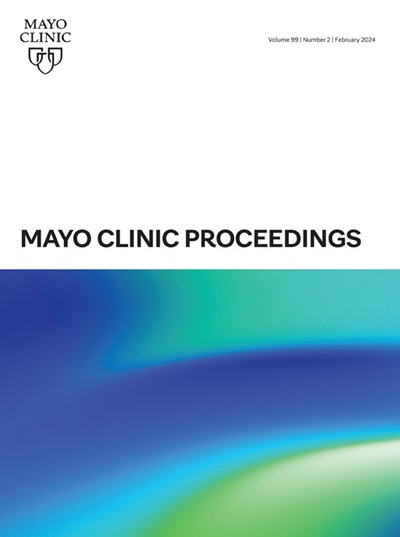Echocardiography Screening of Consecutive Patients With Portal Hypertension Referred to Mayo Clinic for Liver Transplant Evaluation
IF 6.9
2区 医学
Q1 MEDICINE, GENERAL & INTERNAL
引用次数: 0
Abstract
Objective
To determine the prevalence of portopulmonary hypertension in patients referred for liver transplant evaluation.
Methods
Medical records were reviewed for 986 consecutive patients referred for liver transplant evaluation who were screened for pulmonary hypertension with echocardiography from February 1, 2021, to January 31, 2022, across 3 liver transplant centers.
Results
Of 934 patients eligible for analysis, mean (SD) age was 57 (11) years, 558 (59.7%) were men, and 859 (92.0%) were White. Alcoholic cirrhosis and nonalcoholic steatohepatitis represented 640 (68.5%) of the liver diseases. Right ventricular systolic pressure estimated by echocardiography was 35 mm Hg or greater in 147 (15.7%) and less than 35 mm Hg in 475 (50.9%; unable to estimate in 312 [33.4%]). Right-sided heart catheterization was performed in 42 (4.5%) patients; hemodynamic profiles revealed that 12 (28.6%) did not have pulmonary hypertension, 15 (35.7%) had postcapillary venous pulmonary hypertension, 7 (16.7%) had portopulmonary hypertension, 6 (14.3%) had unclassifiable pulmonary hypertension, and 2 (4.8%) had combined pre- and postcapillary pulmonary hypertension.
Conclusion
The percentage of portopulmonary hypertension in patients referred for liver transplant was considerably lower, 7 of 934 (0.7%), than in previous studies, but the reason was unclear.
对转诊至梅奥诊所进行肝移植评估的连续门静脉高压症患者进行超声心动图筛查。
目的确定转诊进行肝移植评估的患者中门肺动脉高压的患病率:方法:对3个肝移植中心2021年2月1日至2022年1月31日期间转诊进行肝移植评估的986名连续患者的病历进行审查,这些患者均接受了超声心动图肺动脉高压筛查:在符合分析条件的 934 名患者中,平均(标清)年龄为 57(11)岁,558(59.7%)人为男性,859(92.0%)人为白人。酒精性肝硬化和非酒精性脂肪性肝炎占肝病的 640 例(68.5%)。超声心动图估测的右心室收缩压大于或等于 35 毫米汞柱的有 147 人(15.7%),小于 35 毫米汞柱的有 475 人(50.9%;无法估测的有 312 人 [33.4%])。42名患者(4.5%)接受了右侧心导管检查;血液动力学检查结果显示,12名患者(28.6%)没有肺动脉高压,15名患者(35.7%)患有毛细血管后静脉肺动脉高压,7名患者(16.7%)患有门肺动脉高压,6名患者(14.3%)患有无法分类的肺动脉高压,2名患者(4.8%)合并有毛细血管前和毛细血管后肺动脉高压:结论:在转诊接受肝移植的患者中,门肺动脉高压的比例大大低于以往的研究,在934例患者中仅有7例(0.7%),但原因尚不清楚。
本文章由计算机程序翻译,如有差异,请以英文原文为准。
求助全文
约1分钟内获得全文
求助全文
来源期刊

Mayo Clinic proceedings
医学-医学:内科
CiteScore
16.80
自引率
1.10%
发文量
383
审稿时长
37 days
期刊介绍:
Mayo Clinic Proceedings is a premier peer-reviewed clinical journal in general medicine. Sponsored by Mayo Clinic, it is one of the most widely read and highly cited scientific publications for physicians. Since 1926, Mayo Clinic Proceedings has continuously published articles that focus on clinical medicine and support the professional and educational needs of its readers. The journal welcomes submissions from authors worldwide and includes Nobel-prize-winning research in its content. With an Impact Factor of 8.9, Mayo Clinic Proceedings is ranked #20 out of 167 journals in the Medicine, General and Internal category, placing it in the top 12% of these journals. It invites manuscripts on clinical and laboratory medicine, health care policy and economics, medical education and ethics, and related topics.
 求助内容:
求助内容: 应助结果提醒方式:
应助结果提醒方式:


